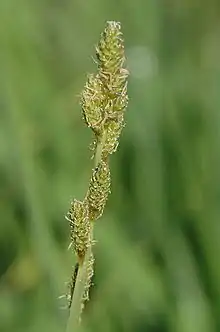blátoppastör
Icelandic

Blátoppastör
Pronunciation
- IPA(key): /ˈplauː.tʰɔhpaˌstœːr/
Noun
blátoppastör f (genitive singular blátoppastarar, nominative plural blátoppastarir)
- hoary sedge, white sedge (Carex canescens)
- 1909, Búnaðarrit, volume 23, number 1, page 45:
- Þar til má telja hengistör (carex rariflora), gulstör (carex Lyngbyei), blátoppastör (carex canescens), hrafnastör (carex pulla) og hnappstör (carex capitata).
- Looseflower sedge, Lyngbye's sedge, hoary sedge, rock sedge and capitate sedge can also be considered.
- 1954, Náttúrufræðingurinn, volume 24, number 1, page 23:
- Bastarður þessi, sem er til orðinn við samæxlun tvibýlisstarar og blátoppastarar, hefur ekki fyrr fundizt hér á landi.
- This hybrid, which has emerged from the crossing of dioecious sedge and hoary sedge, has not previously been found here in Iceland.
- 1978, Tíminn, volume 62, number 186, page 21:
- Blátoppastör myndar blágræna toppa víða í mýrum, svo að auðvelt er að ná í hana o.fl. algengar starir og sef.
- Hoary sedge forms blue-green spikes far and wide in the swamp, so it is easy to get it and other common sedges and reeds.
-
Declension
declension of blátoppastör
| f-s2 | singular | plural | ||
|---|---|---|---|---|
| indefinite | definite | indefinite | definite | |
| nominative | blátoppastör | blátoppastörin | blátoppastarir | blátoppastarirnar |
| accusative | blátoppastör | blátoppastörina | blátoppastarir | blátoppastarirnar |
| dative | blátoppastör | blátoppastörinni | blátoppastörum | blátoppastörunum |
| genitive | blátoppastarar | blátoppastararinnar | blátoppastara | blátoppastaranna |
This article is issued from Wiktionary. The text is licensed under Creative Commons - Attribution - Sharealike. Additional terms may apply for the media files.